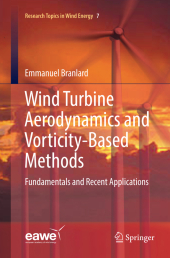 Neuerscheinungen 2018Stand: 2020-02-01 |
Schnellsuche
ISBN/Stichwort/Autor
|
Herderstraße 10
10625 Berlin
Tel.: 030 315 714 16
Fax 030 315 714 14
info@buchspektrum.de |

Emmanuel Branlard
Wind Turbine Aerodynamics and Vorticity-Based Methods
Fundamentals and Recent Applications
Softcover reprint of the original 1st ed. 2017. 2018. xxxi, 632 S. 95 SW-Abb., 84 Farbabb. 235 mm
Verlag/Jahr: SPRINGER, BERLIN; SPRINGER INTERNATIONAL PUBLISHING 2018
ISBN: 3-319-85583-2 (3319855832)
Neue ISBN: 978-3-319-85583-7 (9783319855837)
Preis und Lieferzeit: Bitte klicken
The book introduces the fundamentals of fluid-mechanics, momentum theories, vortex theories and vortex methods necessary for the study of rotors aerodynamics and wind-turbines aerodynamics in particular. Rotor theories are presented in a great level of details at the beginning of the book. These theories include: the blade element theory, the Kutta-Joukowski theory, the momentum theory and the blade element momentum method. A part of the book is dedicated to the description and implementation of vortex methods. The remaining of the book focuses on the study of wind turbine aerodynamics using vortex-theory analyses or vortex-methods. Examples of vortex-theory applications are: optimal rotor design, tip-loss corrections, yaw-models and dynamic inflow models. Historical derivations and recent extensions of the models are presented. The cylindrical vortex model is another example of a simple analytical vortex model presented in this book. This model leads to the development of different BEM models and it is also used to provide the analytical velocity field upstream of a turbine or a wind farm under aligned or yawed conditions. Different applications of numerical vortex methods are presented. Numerical methods are used for instance to investigate the influence of a wind turbine on the incoming turbulence. Sheared inflows and aero-elastic simulations are investigated using vortex methods for the first time. Many analytical flows are derived in details: vortex rings, vortex cylinders, Hill´s vortex, vortex blobs etc. They are used throughout the book to devise simple rotor models or to validate the implementation of numerical methods. Several Matlab programs are provided to ease some of the most complex implementations.
Part I Fluid Mechanics Foundations.- Part II Introduction to Rotors Aerodynamics.- Part III Classical Vortex Theory Results: Optimal Circulation and Tip-Losses.- Part IV Latest Developments in Vorticity-based Rotor Aerodynamics.- Part V Latest Applications of Vortex Methods to Rotor Aerodynamics and Aeroelasticity.- Part VI Analytical Solutions for Vortex Methods and_Rotor Aerodynamics.- Part VII Vortex Methods.- Part VIII Complements.


